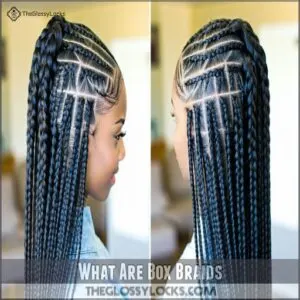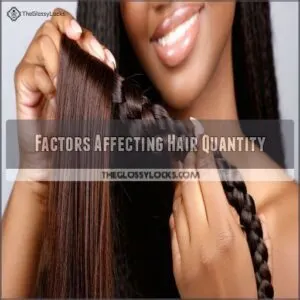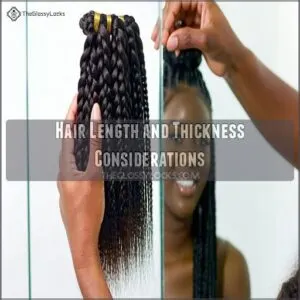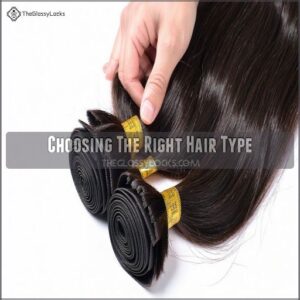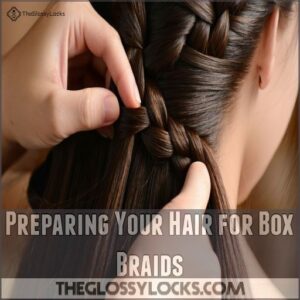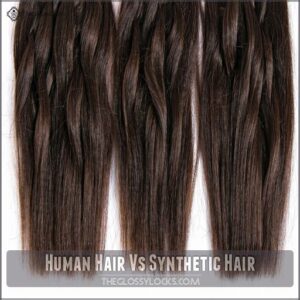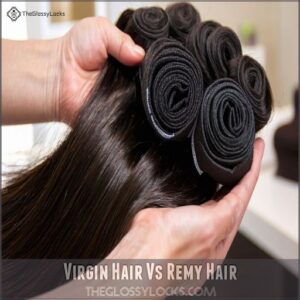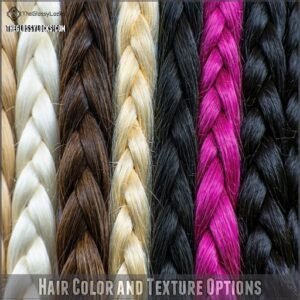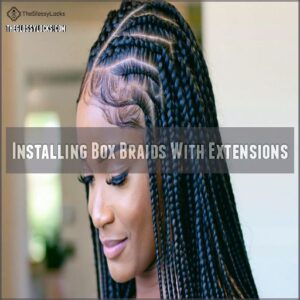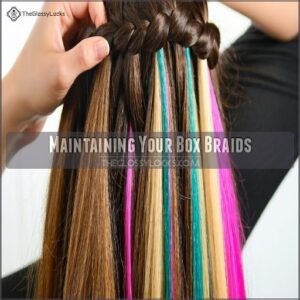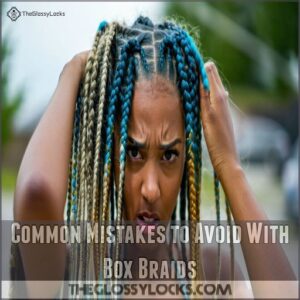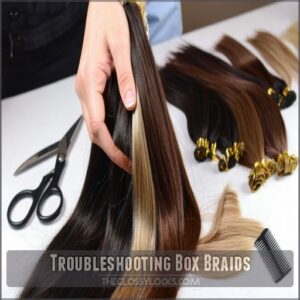This site is supported by our readers. We may earn a commission, at no cost to you, if you purchase through links.
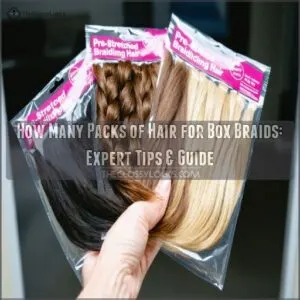
Generally, you’ll need between 3 to 5 packs of pre-stretched hair for a full head, but this can vary.
It all depends on how long, thick, and voluminous you want your braids.
For instance, using six packs of 24-strand, 18-inch pre-stretched crochet hair can provide that wow factor.
Imagine deciding on the thickness and length like choosing the perfect ice cream flavor; the possibilities are endless!
Want more tips and tricks for getting these fabulous braids?
There’s plenty more wisdom to uncover.
Table Of Contents
- Key Takeaways
- What Are Box Braids
- How Many Packs of Hair for Box Braids
- Preparing Your Hair for Box Braids
- Measuring Hair Quantity for Box Braids
- Choosing The Right Hair for Box Braids
- Installing Box Braids With Extensions
- Maintaining Your Box Braids
- Common Mistakes to Avoid With Box Braids
- Box Braids Vs Other Braiding Styles
- Troubleshooting Box Braids
- Frequently Asked Questions (FAQs)
- How much do box braids cost?
- How long do box braids last?
- How much hair do I need for a box braid?
- How many boho box braids do I Need?
- Do you need extensions for box braids?
- How many micro-braids do I need for box braiding?
- Is 3 packs enough for box braids?
- Is 4 packs of braiding hair enough?
- How much hair is needed for box braids?
- How many packets do you need for box braids?
- How do box braids affect natural hair growth?
- Can swimming damage my box braids?
- How long do box braids typically last?
- Are box braids suitable for short hair?
- What products help prevent scalp itching?
- Conclusion
Key Takeaways
- You’ll need 3-5 packs of pre-stretched hair for a full head of box braids, though this can increase to 6-8 packs for longer, thicker styles.
- Your hair’s length, thickness, and desired braid size directly impact how many packs you’ll need – understanding your natural hair texture and moisture needs, especially if you have 4C hair, is key to choosing the right amount of hair for box braids – thicker natural hair typically requires fewer packs, while smaller braids need more.
- Don’t skimp on hair quantity – it’s better to have extra packs than to run short mid-installation, which could leave you with inconsistent braid thickness.
- Consider your braid size goals when choosing packs – jumbo braids need fewer packs but offer less styling versatility, while micro braids require more packs but give you more styling options.
What Are Box Braids
So, you’re wondering about box braids?
They’re three-stranded braids, often using extensions, that are sectioned into neat squares, giving them that signature boxy look—think of them as the stylish, protective cousins of cornrows.
Brief History of Box Braids
Tracing back to 3500 B.C., box braids are more than just a hairstyle; they’re a cultural legacy that has evolved over centuries.
Originating from Africa, these braids symbolize strength and community, with their significance influencing modern trends across the globe.
Whether you’re embracing heritage or personal style, knowing their roots adds depth to your look.
Benefits of Box Braids
Box braids offer a treasure trove of perks.
First, they’re a low-maintenance style, freeing you from daily hair battles.
Second, they boost hair growth by protecting your strands from the harsh elements.
Third, their versatility lets you experiment with countless style options without damage.
Imagine having a protective style that gives you room to flex your creativity!
Types of Box Braids
When exploring box braid styles, do braids help your hair grow by minimizing breakage and reducing hair manipulation, consider classic, jumbo, or micro, each offering unique flair.
Color, texture, length, and thickness choices make your braided hair pop.
Check out this table to explore options:
| Style | Length | Thickness |
|---|---|---|
| Classic | Medium | Moderate |
| Jumbo | Long | Thick |
| Micro | Short | Thin |
| Knotless | Variable | Variable |
| Goddess | Extra Long | Thin/Thick |
Flaunt your braided hair colors and textures with confidence!
How Many Packs of Hair for Box Braids
Figuring out how many packs of hair you need for box braids can feel like solving an algebra problem with too many variables.
Don’t worry, though, because once you consider factors like your desired braid size, hair length, and volume, you’ll quickly determine the perfect amount without pulling your hair out—or braiding it all in by accident!
Factors Affecting Hair Quantity
Getting those box braids right depends on several factors when choosing how many packs of hair you need. Think about:
- Braids size: Smaller braids usually need more hair.
- Hair density: Thick natural hair might require less added hair.
- Braiding style: Different styles can change your hair needs, especially if you have layers that need blending.
- Extension thickness: Thicker extensions might mean fewer packs.
- Desired volume: More packs add volume for a fuller look.
Hair Length and Thickness Considerations
Your hair’s length and thickness can make or break your box braid plan.
Longer hair demands more packs, while thicker hair needs extra for fullness.
Think of it like building a house—more bricks, more stability.
Aim for six to eight packs for long, dense hair.
If your locks are thinner or shorter, four to six packs should work.
Choosing The Right Hair Type
Now that you’ve considered your hair’s length and thickness, let’s talk hair type.
Choosing the right one‘s key—think of it as finding your perfect braid soulmate!
Human hair offers a natural look and feel, while synthetic options are more budget-friendly.
Explore various hair textures, colors, and brands to find the best match for your desired style.
Consider factors like hair quality and longevity when making your decision.
Don’t forget to factor in hair length for a cohesive final look.
Preparing Your Hair for Box Braids
Before you start your box braids adventure, give your hair the spa treatment it deserves by cleansing, conditioning, and adding moisture.
A bit of heat can work wonders, and don’t forget a light oil like almond or shea for that silky finish.
Cleansing and Conditioning
Before braiding, make sure your scalp’s healthy.
A good pre-braid routine involves washing with a gentle shampoo and applying a deep conditioning treatment, such as a deep conditioner for braids.
It’s like giving your hair a spa day—vital for braid longevity!
Choose products that boost hydration, paving the way for lush box braids.
Remember, a happy scalp leads to fabulous braids.
Moisturizing and Lubricating
After a thorough cleanse, it’s time to pamper those strands with rich moisture.
Use moisturizing products like shea or almond oil, spritzing from roots to tips.
Picture it as your hair’s spa day—deep conditioning the scalp, sealing in hydration, and boosting health.
Oil sprays add a protective layer, ensuring smooth sailing for your box braiding journey.
Straightening and Elongating
Think of straightening and elongating your hair for box braids as giving it a smooth runway.
A blow drying session, combined with savvy stretching techniques, sets the stage.
Be careful to balance speed and heat to avoid damage.
Knowing your hair type can be a time-saving tip, ensuring you breeze through the process without a hitch.
Measuring Hair Quantity for Box Braids
When you’re planning your box braids, knowing how much hair you need is essential to avoid any awkward, half-finished hairstyles.
You don’t want to be that person frantically running to the store mid-braid, so let’s break it down with some simple measurements and calculations to get it right the first time.
Measuring Hair Length
Getting those braids just right starts with a trusty hair length chart.
You can also find a helpful box braid hair length guide online at box braid hair length guide.
Grab a tape measure and check the hair from root to tip.
A braiding length guide can shine some light here, especially if you’re aiming for a specific style.
Think of it as using a hair length calculator—precision guarantees your look’s on point!
Measuring Hair Thickness
Now that you’ve measured your hair’s length, let’s tackle thickness.
Grab a single strand; its diameter (hair strand diameter) indicates thickness.
Thicker strands mean fewer braids needed, while finer strands (smaller hair strand diameter) require more.
Consider your hair density too—how many strands grow from each square inch of your scalp.
High density means more hair, impacting the number of braid packs you’ll need.
Hair type and elasticity also play a role; some hair types are more prone to breakage, so you may want extra for safety.
Calculating Total Hair Quantity
To figure out how much hair you’ll need, consider your hair length, braid thickness, and density.
Imagine your hair as a canvas, each strand a brushstroke.
Decide on the box braid size and extension type based on your style goals.
Typically, 6 to 8 packs should suffice, but remember, it’s all about personal preference and flair!
Choosing The Right Hair for Box Braids
Choosing the right hair for box braids can feel like a treasure hunt, but the reward is worth it.
Whether you opt for human or synthetic strands, match the texture and color to your style for a personalized look.
Human Hair Vs Synthetic Hair
Choosing between human hair and synthetic hair for your box braids boils down to what’s important to you—cost, quality, durability, or maintenance? Human hair offers a more authentic look, with various textures such as straight, wavy, or curly that blend seamlessly with natural hair texture.
- Natural texture for a seamless look
- Easier maintenance but with a higher price
- Long-lasting durability for repeated use
- Better quality, despite the premium
Synthetic options are less costly, yet often lack the life span or natural feel.
Virgin Hair Vs Remy Hair
Virgin hair and Remy hair, like superheroes of the braid world, each have their strengths.
Virgin hair is unprocessed and natural, offering high durability and a soft texture.
Remy hair is aligned from root to tip, which minimizes tangling and helps maintain sleekness.
| Type | Cost | Durability | Maintenance |
|---|---|---|---|
| Virgin | High | Excellent | Requires care |
| Remy | Moderate | Very Good | Less effort |
Hair Color and Texture Options
Picking the right hue and texture can be like choosing the perfect outfit.
Braiding hair colors range from natural blacks to bold pastels, offering a natural hair texture or something silkier.
Don’t just wing it—match your hair’s tone with extensions for seamless blending.
Synthetic hair options give you endless choices, so explore until you find your style!
Installing Box Braids With Extensions
To install box braids with extensions, you’ll need to start by sectioning your hair and choosing the right number of packs to achieve the desired fullness.
Grab your favorite comb and prepare for a workout because balancing extension blending and securing the ends is sure to be a test of both patience and stamina.
Sectioning and Braiding
Now that you’ve picked your hair, let’s braid.
First, part your hair into neat sections; even sections mean even braids.
Think of it like building a house—a solid foundation is key.
When braiding, consider that braiding can help protect existing hair strands from breakage and dryness, as explained in more detail about does braiding help hair growth.
Here’s what you’ll do:
- Create square sections using a rat-tail comb for precise hair parting.
- Smaller sections mean more braids, a fuller look.
- Experiment with different braid patterns; there are tons of ideas online!
- Keep your braiding techniques consistent for even braid tightness.
Adding Extensions and Blending
When adding extensions, the magic begins with blending techniques.
Choose your extension length and color carefully: it should seamlessly match your natural hair texture.
Keep an eye on extension density to avoid a bulky look.
Here’s a useful table for guidance:
| Extension Length | Color Matching | Hair Texture |
|---|---|---|
| 10-12 inches | Perfect match | Coarse |
| 14-16 inches | Slight variation | Curly |
| 18-20 inches | Bold contrast | Wavy |
| 22-24 inches | Subtle tones | Straight |
Securing and Finishing
Securing your box braids is like putting the cherry on top of a sundae. Make sure to:
- Secure Ends: Seal with heat or dip ends in hot water for a smooth finish.
- Styling Options: Tie braids in a bun or ponytail.
- Hair Accessories: Add beads or cuffs for flair.
These final touches help your braids last longer!
Maintaining Your Box Braids
Taking care of your box braids isn’t just about keeping them looking fabulous; it’s about ensuring they stay healthy and strong, too.
Spritz them with a moisturizing oil a few times a week, and don’t forget to pamper your scalp with some gentle cleansing to keep everything fresh and beautiful!
Hydrating and Lubricating
Every strand of your box braids craves moisture, like plants needing water to flourish.
Hydrate by spritzing your scalp with water-based products, adding a splash of freshness.
Think of hair oils as a soothing balm for your locks; almond or shea oil works wonders.
It glides over your tresses, keeping them smooth and happy.
For that spa-like treat, indulge in a deep conditioning session with luxuriant hair masks.
It’s a nurturing embrace that fortifies scalp health, bringing life and shine back to your braids, ensuring they remain a crown of glory.
Protecting From Damage
Protecting your box braids from damage is key to keeping them fabulous.
Start with loving care for your scalp; healthy roots lead to gorgeous braids.
Avoid hair breakage by embracing looser styles—tight braids might seem chic, but they’re tough on your hair.
Establish good sleeping habits by using a silk pillowcase or wearing a silk scarf at night to reduce friction.
Use gentle hair products—skip harsh gels and sprays.
Like nurturing a garden, a little TLC keeps your braids blooming.
Remember, protection isn’t just a strategy; it’s your braid noir!
Common Mistakes to Avoid With Box Braids
When it comes to box braids, missteps like choosing poor-quality hair or not using enough packs can ruin your look, faster than spotting a stray hair in your soup.
Make sure your technique is on point to avoid causing a world of tangles and guarantee those braids are ready to slay.
Insufficient Hair Quantity
Keeping your braids looking fresh is key! But, using too little hair is a common pitfall. You’ll end up with:
- Thin, skimpy braids.
- Braids that don’t last.
- A less-than-satisfying look.
Proper planning, including measuring your hair length and thickness, and accurately estimating the needed braid size and hair type, prevents this.
Remember, better to have a little extra than to fall short!
Poor Hair Quality
If you’ve mastered using enough hair, poor hair quality can still trip you up.
Don’t skimp on quality!
Using damaged hair leads to breakage and thinning.
Healthy hair boosts growth and scalp health.
Think of cheap hair like wearing shoes that pinch – it’s uncomfortable and shows.
Aim for premium strands to showcase your style.
Incorrect Braiding Technique
Incorrect braiding can turn your lovely box braids into a hair disaster.
Watch out for tightness—it leads to discomfort and breakage!
An uneven braid can mess up your style and affect scalp health.
Keep these tips in mind:
- Check the tension – not too tight.
- Ensure sections are even – it prevents awkward looks.
- Pay attention to scalp care – avoid irritation.
Box Braids Vs Other Braiding Styles
When deciding between box braids and other styles like Senegalese twists, faux locs, or cornrows, it’s all about what suits your vibe and hair goals.
Each style offers its unique flair and maintenance level, so getting it right can mean the difference between a hair flop and fabulous locks.
Senegalese Twists Vs Box Braids
While you’re deciding between Senegalese twists and box braids, think about style, maintenance, and costs.
To make sure you get the right amount of hair for your chosen style, consider using a hair pack calculator tool to save time and money.
Here’s a simple comparison to help decide:
| Aspect | Senegalese Twists | Box Braids |
|---|---|---|
| Styling Time | Faster install | Takes longer |
| Maintenance | Low maintenance | Moderate upkeep |
| Hair Type | Silky texture | Versatile texture |
| Texture | Smoother appearance | Defined boxes |
| Cost Difference | Often pricier | More affordable |
Which style suits your vibe?
Faux Locs Vs Box Braids
In the dance of hair styling, Faux Locs and Box Braids strut their stuff with flair.
Faux Locs require regular maintenance, including knowing how often to retwist locs, to preserve their long-lasting appearance and durability, offering low-maintenance chic.
Box Braids charm with their versatile, neat finish.
Though pricier, Faux Locs boast long-lasting glamour.
Choose Faux Locs for a bolder look or Box Braids for their classic appeal.
Cornrows Vs Box Braids
Imagine styling your hair with cornrows or box braids.
Cornrows, braided close to the scalp, are flat and intricate; they’re low-cost but require careful maintenance.
Box braids, in contrast, offer a more voluminous look, adding history and popularity to your style.
Both demand time and skill, yet they grant a liberating sense of personal power.
Troubleshooting Box Braids
So, your box braids are looking a little less than perfect?
Don’t worry, we’ll cover how to handle common problems like tangles, breakage, and even how to repair or reinstall braids.
Getting you back to rocking those gorgeous braids in no time.
Dealing With Tangling and Knots
Facing tangles and knots in box braids is like hitting speed bumps on your hair journey.
Understanding the root cause of tangles, such as high porosity hair tangles, can help you tackle the issue.
To smooth things over, use a wide-tooth comb instead of a brush.
Products like detangling sprays and lightweight oils work wonders.
Practice gentle braiding techniques and take preventative measures to keep knots at bay.
You’ll master it with time and patience!
Managing Breakage and Shedding
Ever wonder why your box braids are breaking or shedding?
It might be scalp health or braid tension.
Make sure you’re using the right products and gently detangle to keep hair strong.
Choose products that suit your hair type, and beware of tight braiding.
A bit of patience and the right touch can help minimize breakage.
Repairing and Reinstalling
Dealing with breakage? Time to re-braid those box braids without breaking the bank.
Gently unravel the affected area, assess the cost of replacement hair, and make sure it matches your current style.
Re-braiding might take a bit of time, but it’s a small price for keeping your look on point. Stay patient, and soon you’ll be good as new!
Frequently Asked Questions (FAQs)
How much do box braids cost?
Box braids typically cost between $75 and $450, depending on the salon, stylist expertise, braid length, and complexity.
Prices might also pay extra for hair extensions or unique styles, so always check prices before booking.
How long do box braids last?
With proper care, your box braids can last six to eight weeks. Don’t worry, they’re a low-maintenance style! Regular moisturizing keeps them looking fresh. Enjoy your gorgeous, long-lasting braids!
How much hair do I need for a box braid?
You’ll typically need about 6 to 8 packs of hair for box braids, depending on the length and thickness you want.
Bigger braids may require fewer packs, while smaller ones might need more.
How many boho box braids do I Need?
For boho box braids, you’ll need around 6-8 packs of hair, depending on thickness and length.
Consider mixing textures for that effortless bohemian vibe.
Don’t forget a lightweight oil to keep those braids looking fresh and hydrated.
Do you need extensions for box braids?
Extensions aren’t necessary for box braids, but they offer versatility by adding length, volume, and protection to your natural hair.
It’s your call whether to keep it natural or level up with extensions for extra flair.
How many micro-braids do I need for box braiding?
Did you know box braids often consist of 100-150 micro-braids?
It depends on your hair density and desired thickness.
More strands mean fuller braids, giving you that voluminous look everyone loves.
Remember to aim for balance!
Is 3 packs enough for box braids?
Three packs mightn’t cut it for full and thick box braids.
If you’re aiming for a fuller, voluminous look, consider grabbing at least four to six packs, depending on the length and size you prefer.
Is 4 packs of braiding hair enough?
Four packs of braiding hair usually cover a standard head if you’re going for medium to large box braids.
Consider your hair’s length and thickness; you might need more for smaller, denser braids or fuller coverage.
How much hair is needed for box braids?
The amount of braiding hair you’ll need depends on your hair’s length and thickness, and the size of your braids. Fusion and tape-in hair extensions, for example, require minimum hair length for extensions.
Generally, longer, thicker hair, or smaller braids require more packs.
It’s always best to have a little extra on hand!
How many packets do you need for box braids?
You typically need about 5 to 8 packs of hair for box braids, depending on braid size and length.
Opt for more packs if you want fuller braids—better to have extra than run short!
How do box braids affect natural hair growth?
Box braids don’t hinder your natural hair growth.
They actually offer protection by reducing breakage and retaining length.
However, keeping them in too long or improper care might stress your scalp, potentially affecting hair health.
Can swimming damage my box braids?
Swimming with box braids can lead to frizz and tangling from chlorine and salt.
Protect them by wearing a swim cap or applying leave-in conditioner.
Rinse thoroughly and condition afterward to maintain their style and health.
How long do box braids typically last?
Typically, when it comes to box braids on delicate hair types, such as 4a hair texture and care, gentle handling is crucial to prevent breakage and maintain the natural beauty of curls. Box braids last four to six weeks, depending on your hair type and care routine.
Using a satin bonnet as part of a nighttime hair protection routine can also help reduce friction and prevent breakage. Proper maintenance also prolongs wear but also protects natural hair.
Keep them looking fresh by moisturizing regularly and wrapping them at night.
Are box braids suitable for short hair?
Did you know 60% of women try braids on short hair?
You can rock box braids even with short locks.
Use extensions for length and volume, and embrace your unique style for a bold, confident look.
What products help prevent scalp itching?
To prevent scalp itching, use soothing scalp oils like tea tree or peppermint.
Scalp oils and leave-in conditioners soothe irritation and keep your scalp hydrated, helping you stay itch-free.
Moisturize regularly with leave-in conditioners.
Try anti-itch sprays.
Conclusion
So, you’ve learned how many packs of hair for box braids you’ll need, the factors influencing your decision, and how to choose the right hair.
Remember, planning is key; measuring your hair, considering length and thickness, and selecting quality extensions will guarantee stunning results.
You’ll have amazing, long-lasting box braids.
Don’t forget to account for thickness and desired volume when determining how many packs of hair for box braids you need.
Now go forth and braid!

